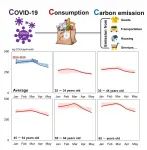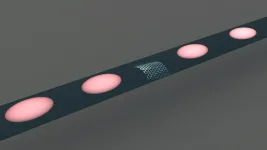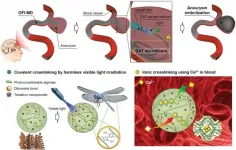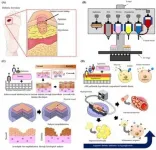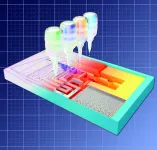Scientists develop better way to block viruses that cause childhood respiratory infections
2021-05-10
(Press-News.org) MADISON - By engineering a short chunk of protein, or peptide, that can prevent the attachment of human parainfluenza viruses to cells, researchers have improved a method in rodent models intended to help keep children healthy.
Human parainfluenza viruses, or HPIVs, are the leading cause of childhood respiratory infections, responsible for 30% to 40% of illnesses like croup and pneumonia. The viruses also affect the elderly and people with compromised immune systems.
To sicken people, HPIVs must latch onto cells and inject their genetic material to start making new viruses. HPIV3 is the most prevalent among these viruses. There are currently no approved vaccines or antivirals for HPIV3 infection in people.
In a study led by the Sam Gellman lab in the chemistry department at the University of Wisconsin-Madison, and the lab of Anne Moscona and Matteo Porotto at Columbia University, researchers built upon years of work on peptide treatments to generate one capable of blocking the HPIV3 attachment process.
The researchers published their findings April 7 in the Journal of the American Chemical Society.
To enter host cells, HPIVs use specialized fusion proteins that resemble three corkscrews laid side-by-side. Earlier work by the Moscona-Porotto lab showed that scientists could a partial chunk of this corkscrew protein from HPIV3, introduce this peptide to the virus, and prevent the corkscrew from driving the infection process. The peptide, itself a corkscrew, essentially zippers up with the virus's corkscrews, creating a tight bundle of six corkscrew shapes.
The new peptide persists longer in the body, making it about three times more effective at blocking infection in rodent models of disease than the original form.
The research team started by trying to engineer the original peptide to be more resistant to protein-digesting enzymes in the body, which can easily shred proteins and make them useless. So, the Gellman lab turned to unusual building blocks to create a hardier peptide.
Cells build proteins out of alpha amino acids. But chemists can create beta amino acids, which are similar but have an extra carbon atom. When peptides use these beta amino acid building blocks, they often take a different shape because of the extra atom. This can help a peptide hide from protein-digesting enzymes and survive longer.
However, the researchers also knew that if the peptide's shape changed too much as a result of these unusual building blocks, they might not lock together with HPIV's corkscrew fusion protein.
That's where the Gellman lab's decades of experience testing and modifying beta amino acid-containing peptides became critical.
"We know which side of the peptide is binding to its protein target. So, we (knew that we) can modify only residues that are not directly involved in binding the viral protein," says Victor Outlaw, a postdoctoral researcher in the lab and one of the co-first authors of the report. In lab tests, they saw that the carefully modified peptide still bound strongly to the virus's protein.
In another improvement pioneered by the Moscona-Porotto lab, the scientists hooked the peptide up to a molecule of cholesterol. This fatty addition helps the peptide slide into the greasy cell membrane, where it can best block the virus.
"Our hypothesis was that the combination of beta amino acids and cholesterol would increase anti-viral efficacy," says Outlaw, who explained that the cholesterol helped get the peptide to where it needed to go, while the shape change from the beta amino acids allowed the peptide to persist longer in the body.
As the research team hoped, when they gave the new peptide to cotton rats it lasted much longer in the lungs than the previous version did thanks to its resistance to digestion by enzymes. The peptide was delivered into the rats' noses.
To test how well the peptide worked to prevent infection, cotton rats received the new peptide before they were exposed to HPIV3. Compared to animals given no antiviral peptides, those given the improved peptide had 10 times fewer viruses in their lungs.
And compared to the peptide that was more susceptible to enzymes, the hardier peptide reduced viral load by about three times, suggesting that the new peptide's ability to avoid digestion in the body helps it better block infection.
While the approach hasn't yet been tested in humans and researchers must further refine and test the system, it does provide a new strategy for potentially preventing or treating these common infections.
The research collaboration is now looking to make second-generation peptides that last even longer in the body. They also want to test how well the modified peptide might block infection by related viruses. That additional research could move the peptide treatment closer to clinical trials.
"This was a very fortunate coming together of groups that had complementary needs and capabilities," says Gellman. "It's really been a great joint effort."
INFORMATION:
This work was supported by the National Institutes of Health (grants R01AI114736, R01 GM056414, F32 GM122263 and T32 GM008349.)
--Eric Hamilton, (608) 263-1986, eshamilton@wisc.edu
[Attachments] See images for this press release:

ELSE PRESS RELEASES FROM THIS DATE:
2021-05-10
Autistic people have far greater risks of long term physical health conditions than others, but the reasons for this remain unclear. New research from the University of Cambridge suggests that unhealthy lifestyle habits may be an important contributing factor. The results are published today in the journal Molecular Autism.
Earlier research suggests that autistic people die 16-35 years younger than expected, and that greater health problems may contribute to this risk. The present study is the first to consider the diet, exercise, and sleep patterns of autistic adults and how these patterns may relate to health outcomes.
The team at the Autism Research Centre in Cambridge developed an anonymous, online survey about lifestyle choices and daily habits, personal medical history, ...
2021-05-10
The Covid-19 pandemic, like many other health crises, has had unequal effects on the U.S. population, with communities of color often hit the hardest. A new study co-authored by an MIT professor identifies a related challenge: Different social groups have different reactions to the fact that Covid-19 has generated those health inequities.
More specifically, the study, based on a multilayered survey of U.S. residents, finds a divergence among racial groups when people are informed about the varying effects of the pandemic. Upon learning more about the social distribution of Covid-19, Black Americans tend to gain a better understanding of their risk. But among white Americans given the same information, ...
2021-05-10
Australian photovoltaics researchers have made a 'cool' discovery: Singlet fission and tandem solar cells - two innovative ways to generate solar power more efficiently - also help to lower operating temperatures and keep devices running for longer.
Tandem cells can be made from a combination of silicon - the most commonly used photovoltaics material - and new compounds like perovskite nanocrystals, which can have a larger bandgap than silicon and help the device to capture more of the solar spectrum for energy generation.
Singlet fission, meanwhile, is a technique that produces twice the electronic charge carriers than normal for each photon of light that's absorbed. ...
2021-05-10
A chemical that the NSW government has recently partially banned in firefighting has been found in the pups of endangered Australian sea lions and in Australian fur seals.
The finding represents another possible blow to Australian sea lions' survival. Hookworm and tuberculosis already threaten their small and diminishing population, which has fallen by more than 60 percent over four decades.
The new research - part of a long-term health study of seals and sea lions in Australia - identified the chemicals in animals at multiple colonies in Victoria and South Australia from 2017 to 2020.
As well as in pups, the chemicals (Per- and polyfluoroalkyl substances - 'PFAS') were detected in juvenile ...
2021-05-10
Despite the rapid and significant changes in consumption patterns witnessed during the initial months of the COVID-19 pandemic, Japanese households maintained their normal levels of greenhouse gases emissions. The "anthropause" -- reduction of human activity due to the pandemic -- made headlines last summer, but factory shutdowns and broken global supply chains did not translate into the adoption of eco-friendly lifestyles for the average household.
"During the early COVID-19 period, we could witness lifestyle changes happening around us fast, so we decided to explore the environmental impacts of these lifestyle changes. Some other research at that period was showing that the production-side greenhouse gases emissions ...
2021-05-10
The promise of a quantum internet depends on the complexities of harnessing light to transmit quantum information over fiber optic networks. A potential step forward was reported today by researchers in Sweden who developed integrated chips that can generate light particles on demand and without the need for extreme refrigeration.
Quantum computing today relies on states of matter, that is, electrons which carry qubits of information to perform multiple calculations simultaneously, in a fraction of the time it takes with classical computing.
The co-author of the research, Val Zwiller, Professor ...
2021-05-10
Cerebral aneurysms are malformations caused by abnormalities on the walls of blood vessels in the brain. When these blood vessels rupture, about 30% of the sufferers die on the spot, giving these the rightful label of 'ticking bombs in the head'. Recently, a research team at POSTECH has come up with a new treatment that can disassemble these time bombs by filling the aneurysm in blood with a new method.
In order to overcome the shortcomings of coil embolization, POSTECH's joint research team (Professor Joonwon Kim and Dr. Jongkyeong Lim of the Department of Mechanical Engineering with Professor ...
2021-05-10
The skin, which covers the surface of the human body, is its largest organ. It is the first organ to show changes stemming from organ or physiological activity. It is especially common for diabetic patients to suffer from skin diseases or infections. Recently, a POSTECH research team has succeeded in creating a 3D artificial skin that enables observation of skin diseases of diabetic patients.
A research team led by Professor Dong-Woo Cho and Minjun Ahn of POSTECH's Department of Mechanical Engineering and Professor Byoung Soo Kim of School of Biomedical Convergence Engineering at Pusan National University has ...
2021-05-10
A decade already passed from the first use of bioresorbable vascular scaffold in percutaneous coronary interventions. The first studies - by using surrogate endpoints - showed some superiority of BRS vs. metallic drug-eluting stent in terms of the so-called vascular restoration therapy with recovery of vasomotion and vascular pulsatility when the scaffold was absorbed.
Nevertheless, after these first promising findings, larger and randomized clinical trials and subsequent meta-analyses, powered to hard clinical endpoints, showed that bioresorbable vascular scaffolds, made ...
2021-05-10
Researchers at KU Leuven (Belgium) have developed a 3D printing technique that extends the possibilities of lateral flow testing. These tests are widespread in the form of the classic pregnancy test and the COVID-19 self-tests. With the new printing technique, advanced diagnostic tests can be produced that are quick, cheap, and easy to use.
The COVID-19 pandemic has made everyone aware of the importance of rapid diagnosis. The sale of self-tests in pharmacies has been permitted in Belgium since the end of March. This self-test is a so-called lateral flow test. Using a ...
LAST 30 PRESS RELEASES:
[Press-News.org] Scientists develop better way to block viruses that cause childhood respiratory infections


